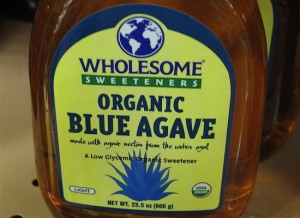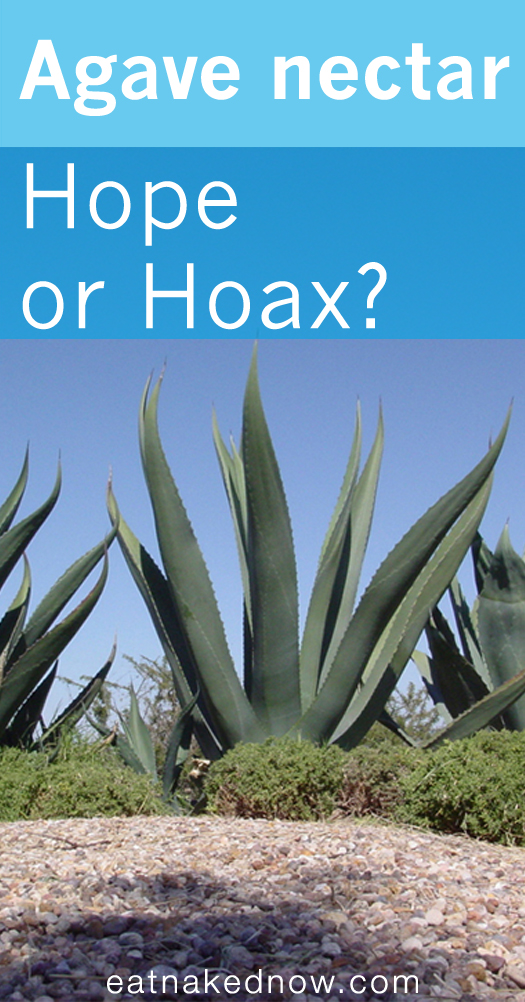Agave nectar. If you have any interest whatsoever in healthy eating you’ve at least heard of it, you’ve definitely consumed it, and you’ve probably purchased it at some point. It seems overnight it went from being just one among many mysterious non-sugar sweeteners dotting health food store shelves to the darling of everyone and anyone trying to do the right thing.
I can still remember when I first learned about agave nectar. An all-natural ‘raw’ sweetener made from the same plant that so generously gives us tequila? And low-glycemic to boot? Sounds too good to be true.
Turns out it is.
Like so many of the food products disguised as the healthy magic bullet alternative (think margarine replacing butter, soy ‘meats’ and textured vegetable protein replacing animal products), agave nectar is more of a marketing hoax than anything else. And, as with so many of these ‘alternatives’, it turns out to be worse than the real thing – which in the case of agave is sugar.
Does this surprise you? It did me. And from the fact that I continue to see it displayed proudly and prominently on the labels of even the healthiest of food items, I think it’s safe to say it would surprise many of even the more informed health advocates out there.
 Chemically speaking, agave is essentially the same as high fructose corn syrup (HFCS). Need to read that again to take it in? Go ahead, I’ll wait. Yes, you read that right. In fact, it can actually be worse for you than HFCS because some brands of agave are even higher in fructose. At its best, agave contains 55% fructose, the same percentage as HFCS. At its worst, agave can contain up to 95% fructose! This makes it much worse than HFCS. And don’t even get me started on HFCS…
Chemically speaking, agave is essentially the same as high fructose corn syrup (HFCS). Need to read that again to take it in? Go ahead, I’ll wait. Yes, you read that right. In fact, it can actually be worse for you than HFCS because some brands of agave are even higher in fructose. At its best, agave contains 55% fructose, the same percentage as HFCS. At its worst, agave can contain up to 95% fructose! This makes it much worse than HFCS. And don’t even get me started on HFCS…
But it’s low-glycemic! How can it be bad for you?
Here’s a very important point about fructose generally: fructose does not increase insulin levels because it does not break down into glucose (blood sugar). This is why it’s described as “low-glycemic.” Food manufacturers twist this fact into suggesting it’s fine for those watching their blood sugar levels. BUT, fructose does lead directly to insulin resistance, which is ultimately a much worse situation (and one small step away from full-blown diabetes). The way fructose is metabolized in your body basically puts it on the fast track to fat storage, insulin resistance, and fatty liver.
Now, excessive amounts of fructose from any source is damaging, but at least when it comes in the form of a whole fruit it comes with all sorts of other nutrients – vitamins, minerals, fiber, antioxidants, and so on. (Note: I recommend you limit your fruit intake to 1-2 servings per day and always stay away from fruit juice.) Unlike fruit, agave is highly processed, and so all of these nutrients are obliterated and you’re left with just the fructose, and massive quantities of it that you’d never find in nature.

The myth around agave is strong. Manufacturers would love you to believe that it comes directly from the sap of the plant. Yet most brands use the root of the cactus and an intensive extracting process to convert that root into the sweet ‘nectar’ we get in the stores.
Now, there are some agave producers who truly are bottling the sap without processing, and these companies come closer to their health claims. Trouble is, they’re hard to find. All of them are claiming to be natural and a healthier alternative to sugar; many of them claim to be raw. Some of them are organic, and they may well be, but being organic doesn’t affect the fructose levels or processing. Ultimately, there’s no regulatory body ensuring what they say has any meaning or credibility, putting us as the consumers in a tricky spot.
My suggestion? Avoid agave in all its forms altogether. Either cut the sweet stuff completely (our 14-day sugar control detox can help you do this) or opt for a truly natural and naked alternative.



Great post! I agree. To much sugar of any form is not good. There are also some other factoids about Agave and the FDA and how you might not actually be eating true agave nectar due to some guidelines that are OK’d by the FDA to “hide” Great post thanks for sharing your research.
I was tricked about agave nectar, too! I didn’t realize that most companies use such an extensive extracting process to get it. I agree that too much sugar in any form is bad for you. Thanks for the great article!
Firstly, its a very large leap to compare Agave to HFCS.
Fructose is found in many fruits, dates, etc. True, agave does contain mostly fructose and a small percentage of glucose.
However, Agave contains natural fructose, there is no comparison between a natural form of fructose, such as in fruit or from agave, and the chemically-processed, pesticide-laden, genetically-modified High-Fructose Corn Syrup (HFCS)
Everything is ‘technically processed’… if you put an apple in a juicer it is ‘processed’. The key is whether there is harmful adulteration during that ‘process’. Use a brand you know and trust.
Secondly, regarding the Low glycemic, its the best option for diabetics who can’t consume honey or sugar which contain high GI and for those who don’t want to use artificial sweeteners.
Agave that is certified Organic, Kosher, etc. is actually highly regulated. Its not an easy process to obtain such certification.
Somes sources: http://www.sciencedaily.com/releases/2010/03/100323171630.htm
http://www.livestrong.com/article/543482-natural-fructose-vs-crystalline-fructose/
@mike – thanks for your comments, but I beg to disagree. Natural fructose is not what we have in the case of agave. I hate to dispel the myth, but most brands (albeit not all of them, but most) ARE highly processed using incredibly intensive processes – quite unlike juicing an apple. Here is an excellent article that goes far deeper into the science than I have: http://articles.mercola.com/sites/articles/archive/2010/03/30/beware-of-the-agave-nectar-health-food.aspx
As for low glycemic – I am not condoning high glycemic foods – I highly encourage people to steer clear of them. But it is deceptive and false to market something to diabetics as “low-glycemic” when in fact it is contributing greatly to insulin resistance, which is just as much a big deal for diabetics (or pre-diabetics, or any of us for that matter) as a food’s glycemic load.
Can you include some sources for this story? I’ve read about this in a few places and want to share it with others who may be skeptical because they’ve bought into the ‘miracle-alternative’ hype. It’s gonna be an uphill battle getting people to believe they’ve been conned.
All,
Processed fructose is still fructose. Unprocessed fructose is still fructose. Fructose is always going to be fructose. How it becomes fructose is not so important once it is fructose.
It still causes obesity, hypertension, fatty liver, heart disease, diabetes and more. Agave is mostly fructose. Stay away from it.
Bryan
I hear most people say turn to maple syrup or honey. However, I use the agave that you have pictured above, and it is similar to maple syrup. Once they extract the nectar they have to heat it just like maple syrup. This is how it becomes sweeter with fructose, like maple syrup. I believe there are some brands out there that possibly do this chemically, which we need to stay away from, however after studying this company’s claims, it does not process its agave like that. Just like fruit, however, all in moderation.